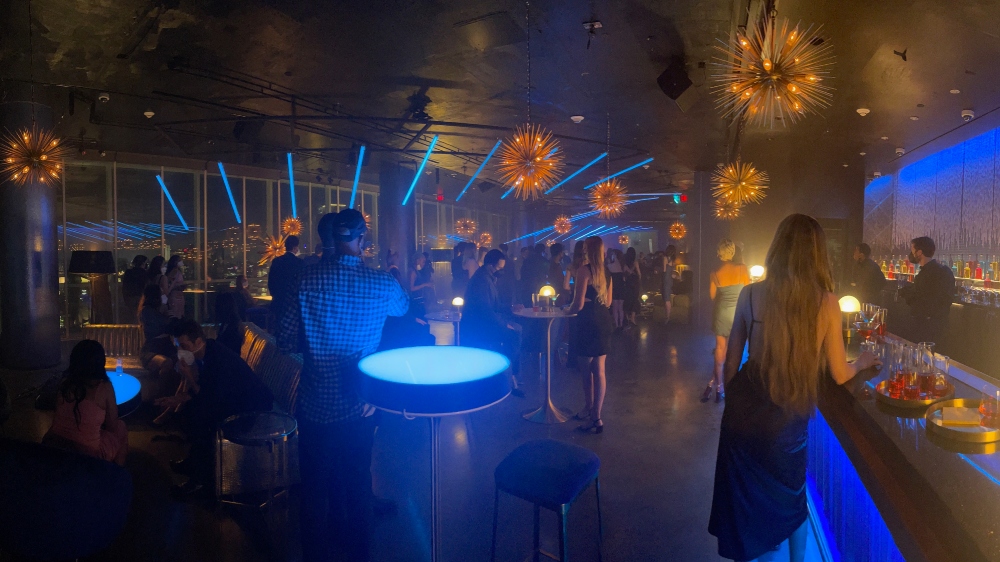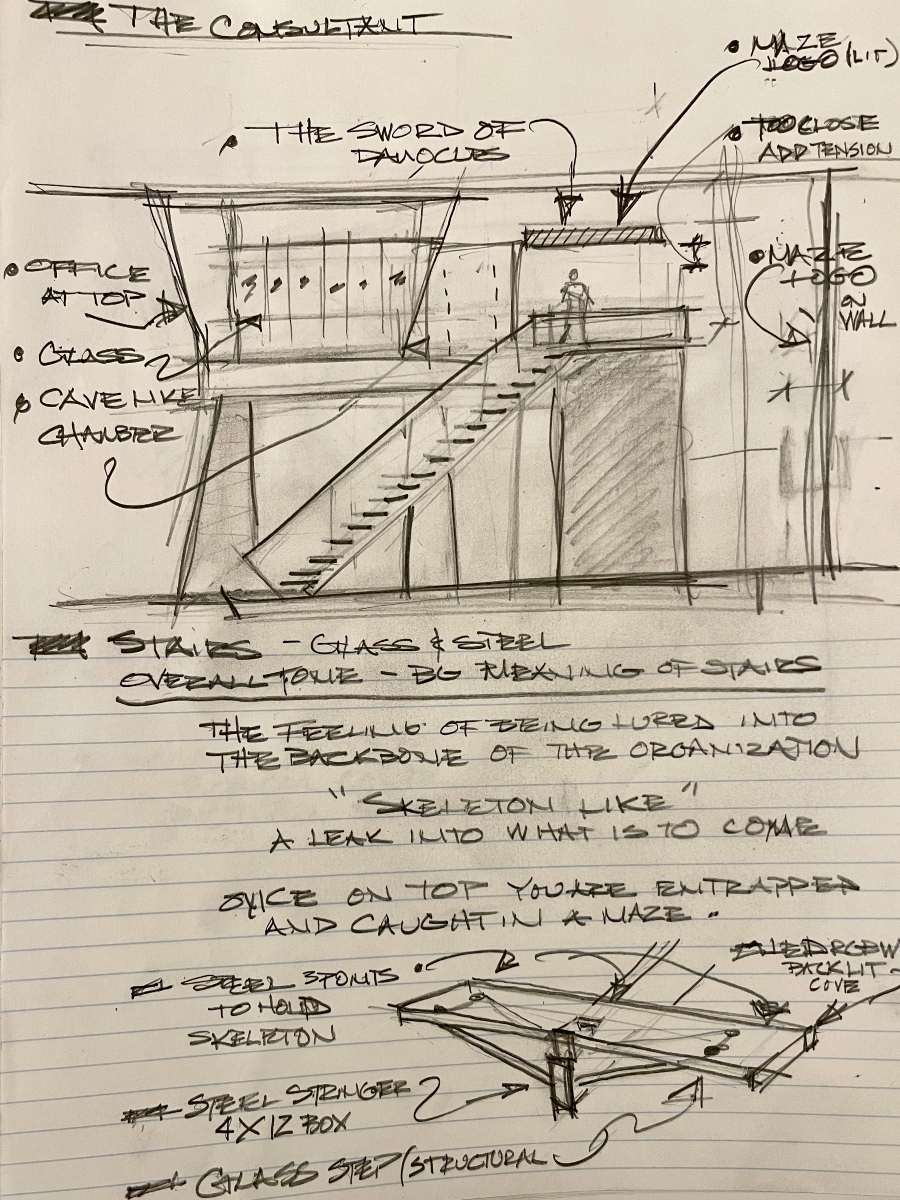Back when Clarence Major III was designing raves, he didn’t harbor any major designs on a career as a Production Designer. Yet here we are decades later, and Major is a 25-year Hollywood veteran with credits spanning from Higher Ed and Mike Epps: Inappropriate Behavior to Amazon Prime Video’s new show The Consultant and the upcoming sci-fi feature War of the Worlds, not to mention countless commercials. He has also served as an Art Director on 10 Items or Less, 9-1-1: Lone Star, and The Morning Show.
Created and produced by Tony Basgallop, The Consultant is based on Bentley Little‘s book of the same name, and the darkly comedic thriller stars two-time Oscar winner Christoph Waltz as Regus Patoff, a cold, no-nonsense, and slightly malevolent figure who takes over as the boss of tech giant CompWare following the murder of its founder. Nat Wolff co-stars in the series alongside Brittany O’Grady and Aimee Carrero.
Much of the action takes place at CompWare’s elaborate corporate headquarters, which is a production designer’s dream assignment, and nothing less than a character unto itself. Below the Line caught up with Major via Zoom for an extensive conversation about his work to date, with an emphasis on The Consultant, which features several interesting religious allegories that he also touched upon.

Below the Line: How and why did you get into the production design game?
Clarence Major III: I started kind of sideways. I was a club owner and did raves, but they were very theme-oriented raves. I was building lots of things like dayglow, 10-foot-high superheroes, and robots. I was creating environments for the raves, and someone said, ‘Hey, you’re so good at this. You should be decorating. You would be a good decorator in film.’ I wasn’t sure about what that was, but that was my side-way in.
I started doing commercials. I was working with some production designers and art directors. I had gone to school prior to that, and I went back to school. I went to Art Center in Pasadena. I also studied Human Development at Pacific Oaks College. My parents are creative, so I grew up Bohemian. I’m from the Midwest — Omaha — but my dad and I share the same name. Remember the third (Clarence Major III)! When you search for me online, you usually find him because he’s a writer and a poet. That’s why my website is not ClarenceMajor.com, because he took everything before I could even get into the game! My actual website is CLMajor.com, but later I was able to get ClarenceMajor.design. Wikipedia thinks I’m an imposter, so they won’t even make a Wikipedia page about me. If you look at my dad’s Wikipedia page, it’s crazy. He’s a renaissance man. I talked to him two weeks ago. He’s still working on four books at the same time.
My mom was a fine artist, a graphic artist, a graphic designer, and sort of an art therapist to children of battered women. So, I grew up with a lot of artists, musicians, and professors around us. It was a multicultural, hippy-dippy kind of scenario. Having that as my background, and then coming to what I’m doing now, became the catalyst [for] me going into this whole thing.
I worked for Alex McDowell, Alex Hajdu, and some other designers when I first came up. When I was working for Alex Hajdu, I was able to learn about breaking down scripts. I did modelmaking and I got a chance to build sets. I’ve done every single piece of the art department. I was a lead man, a decorator, and I managed a prop house that we had. I got a chance to do a lot of commercials with him and some movies. Then, I went off on my own and started doing music videos. I’ve done many features, and close to 1,000 commercials at this point.

BTL: What brought you to The Consultant?
Major: I was referred by a friend and came onto the project. It was great working on that. We started off at a nice, very intense pace. We had four weeks and three days to do the pilot.
BTL: Did you read the book?
Major: I read the book, but as I started to read the book, I thought, “Wow, Tony is really taking this in another direction.” It’s just a stepping-off point because in the book it’s a little bit more intense [and] a lot gorier…
BTL: …With a little less comedy, right?
Major: Yes! I love Tony’s sensibilities. It’s really easy to design for him. His words are so vivid for me. It’s [certainly] a different take on that book.

BTL: On some jobs, sets are characters, and on other jobs, sets are not meant to stand out but to blend into the background. How do you determine whether a set is a character unto itself or just a place where the human characters live, work, and play?
Major: For me, I absolutely need to have a story. I need to know that narrative. I try to design everything from that narrative, based on it being a character — either silent or out in front. I did get a chance to design the staircase on this. That became this whole thing about being in a space where you were in a perilous position, so I wanted to make sure it was unstable. Using the three points to hold a glass staircase up and the spinal quality of that was very much a part of the narrative of what I was trying to get at.
I was the Art Director on the pilot. I did get a chance to design some pieces, but I designed the show beyond that… from [Episode] 2 [through] 8. Patoff was a mixture of intrigue, mystery, and dark, sinister, spiritualism. He was always trying to show you a shiny object to ensnare you and pull you into a dungeon. That’s what I was always trying to do in taking this little thread through the hole and through several of my sets; the idea that it’s giving you a little piece of candy and pulling you into a place where you become ensnared into a labyrinth. Out of desperation, you’re wanting to get to that next step. While you’re in that labyrinth, you don’t know what is going on and may not be able to find your way out — kind of like The Shining.
That’s what I was always trying to do with the idea. Making prisons, taking you from the shiny and new to a dungeon. When Patoff goes into the records room, he’s coming from the shiny and modern into an elevator, and then we drop down into the server room, which I designed as a maze. We took those servers and made sure we redesigned them with lighting on both sides, so we would be able to navigate the subtlety of who he is when you walk through, so as to never make a straight line. You always have to turn a corner.

BTL: A circuitous route…
Major: Right. Once you get in, you’re going into a dungeon-like scenario. The elevator is aluminum, steel, shiny, and high-tech, but then the walls start to become concrete and broken. When we come to the records room, there’s a steel-rusted door that doesn’t need to be there. It’s like, “How did this get here? What is this?” When we’re in the room — with water-dripping pipes — you are in the belly of something and you think, “This is a dungeon.”
It’s the same thing with the front. When we come into the building, the big cavernous entrance is like a cave. As we get into Patoff’s office, there’s a chamber outside. You’re in the same sort of thing when you’re going in. I did the same thing with the jewelry store, coming from something, because in its heyday it was a beautiful space. Now, Patoff has lured him in. He needed the work, and he needed to do those things. It was so sad for me. I was there. When his wife took the ring off, I almost cried. She takes the ring off. It’s like, ‘Okay, we have to do this.’ He’s sucking the life out of everyone. For me, with that room, it was important to make sure that the smelting room beyond his desk was the same thing. You’re in a dungeon. We were able to pull that off.
Also, Beth Wooke was my Set Decorator on the show. We were toying with these ideas of impending danger. When we’re in the club, there’s a light fixture where there are knives over his head. We kept having these conversations about the Sword of Damocles. [Craig] wants power and he wants to move forward. He gets the idea, “Oh, I’m going to have a position…” but do you really want that position? “What do I have to do? What am I giving up?” If you notice, we tried to bring in a lot of that.
Inside the main space — it’s not my concept, because Ramsey [Avery, the other credited Production Designer] came up with this concept of having the monitors with multiple bars — [but] I carried that theme beyond that, into making sure that we always had something in the environment that resembled prison bars. Behind Craig, when he’s in the club, you see this round, cylindrical light fixture that is made out of gold bars.
Inside the smelting room in the jewelry store, there’s a big cage. We also made sure that all the tools became these pieces inside of a trap. Even when Patoff goes to the robotics company at the end, [both] in the lobby and when he’s walking through [the office], we have these silver bars on all the fixtures or on the benches as you’re walking down the hall, and when we see him in the lobby. We tried to bring that same theme when Elaine is on the date; the same thing with light. She’s still trapped.

BTL: I’ve been paying attention online to reactions to the show, and viewers are making connections between the dark and light elements of the sets, and good and evil. Or they see Level 316 and John 3:16, the Bible verse about eternal life. How much of a religious allegory did you want to thread in there with the sets?
Major: For me, it was part of what I was paying attention to, but not totally. I knew people could read into that. There are lots of things about this.
BTL: War of the Worlds is next, but you actually finished that before starting The Consultant, right?
Major: We’ve been in post for a while. There are a lot of visual effects in that. Universal is looking at a cut right at the beginning of April, so I can’t talk much about it.
BTL: What else do you have in the works?
Major: I’m reading some scripts, but I’m not into something at the moment. I just finished a commercial with Errol Morris. I’m looking at some projects, but nothing’s landed at the moment. I haven’t had a break for two-and-a-half years, so I’m happy to take a little bit of a moment to breathe. I have two kids and one of my sons is doing an international robotics competition, so we’re going away. He’s been building robots since he was eight or nine [and] he’s the head coder for the robot, so that’s nice.
The Consultant is now streaming on Amazon Prime Video.





